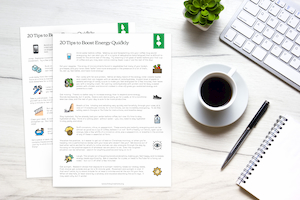As I sat down to write this post, I thought about writing about why you may want to go gluten-free, how gluten is inflammatory, how to figure out whether gluten is impacting you, and why I personally have been gluten-free since 2014. But then I realized that I already had a blog post that covered all of those topics … here it is! The short version is: I think most (but not all!) people will feel better on a reduced-gluten or gluten-free diet. You can test by doing an elimination diet to see if you feel better, but I also help people figure out whether gluten is making them feel poorly with my personalized health coaching.

So, with that already covered, today’s post will discuss how to go gluten-free if you’ve already decided to do so. I want to help you go gluten-free in a way that makes you feel great, and that doesn’t involve running out to the nearest health food store to grab any product labeled gluten-free. Often, when people do, they end up feeling just as (or more!) sluggish, bloated, and digestively uncomfortable as they were before. This is because many gluten-free products on the market contain lots of added sugar, artificial preservatives, an excess of refined grains, or other less-than-ideal ingredients. Just because a package says “gluten-free” does not mean it is healthy!
Here are some tips on how to go gluten-free in a healthy way:
- Remember that the healthiest foods are naturally gluten-free. We feel best and protect our long-term health when the majority of our diet is comprised of vegetables, fruits, nuts, meat, eggs, and other whole foods that naturally do not contain gluten. So, whether you choose to eat gluten-free or not, load up on these!
- Think of gluten-free products as “extras,” not the basis of your meals. Whether it is a gluten-free tortilla, a no-sugar-added cookie, or a grain-free cracker, it’s still an extra in your diet, not the center of the plate.
- Check the ingredient list, not just the front of the package. Look for sources of added sugar (here’s how to find it!), artificial preservatives, and other chemical-sounding ingredients that you don’t keep in your pantry. If you don’t recognize the name, I’ll bet your body has a hard time recognizing it, too! For more on how to read labels, check out my label reading webinar!
- If it’s not labeled, “gluten-free,” check the ingredient list. Below the ingredients should be a line in bold print that says “Contains:” with a list of the common allergens, including wheat, eggs, soy, almonds, cashews, coconut, and more. If it says “Contains: Wheat,” it contains gluten!
Here are the top sources of gluten to watch out for:
- Bread
- Tortillas
- Pasta
- Baked goods (like cookies, muffins, buns, waffles, and pastries)
- Crackers
- Cereal
- Beer
- Soy Sauce
- Other sauces, dressings, and gravies
- Energy bars
- Meat substitutes
Want a list of my favorite gluten-free products for each of the above categories? Just enter your email here for a free download with links to my favorite gluten-free substitutes! (Allow just a few minutes for the email to hit your inbox! If you’re already getting my emails, click here to download.)
Now it’s your turn … What are your favorite gluten-free substitutes? Do you minimize or avoid gluten in your own diet?




“Just because a package says “gluten-free” does not mean it is healthy!” – I agree with this statement 1000%. I think that a lot of companies have tried to capitalize on people’s choices to live healthier and go gluten free by marketing products that are gluten free, even though the products themselves aren’t healthy. As you’ve said, less processed foods are always the best regardless of whether or not you go gluten free.